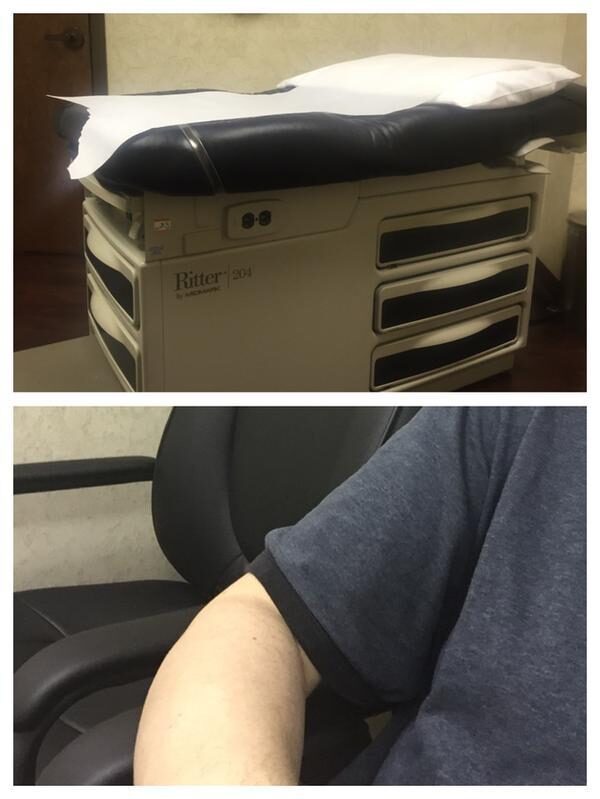
It's a pretty common facilitation technique to do a “plus / delta” discussion at the end of a meeting, exercise, etc.
In the plus column go the things that went well, were enjoyable, were helpful, and should repeated.
The “deltas” (which is meant to seem more positive than saying “minuses,” I guess) are the things that could be improved upon. A “delta” is a gap between where you are and where you want to be.
Last week, I was hit really hard by a case of the flu. You, the dear reader, might not have noticed because I thankfully had an inventory of blog posts built up that were scheduled to go out. For shame, Mark the Lean blogger sometimes has inventory? Well, sometimes inventory is useful :-)
On Monday, when I felt this coming on, I called my normal primary doctor and I was able to get in for an appointment an hour later, because there had been a cancelation.
PLUS: Being able to get same day access to an appointment (even if some luck had been involved)
After being in the office for just over an hour, nobody said “let's plus / delta your visit before you go.” That never happens in a clinic setting. At best, you might get some sort of survey after the fact. But, the point of a good constructive “plus / delta” discussion is to give immediate feedback to those who might be able to make some improvements.
Can you imagine how a clinic might improve if an office manager or somebody at the front desk did a short “plus / delta” with each patient? Does anybody, anywhere do this?
IF they had asked, these would have been the plus / deltas from my visit. Even when running a fever, I have an eye for waste.
DELTA: When I parked my car and walked up the flight of the stairs to the clinic (which wasn't easy when feeling really weak from the flu), I was asked, “Can I see your insurance card?” I'm a regular patient and they don't normally ask for the card each time. “Well, the doctor has decided we need to see the card every time now.” Thankfully, I keep the card in my car. I had to walk down and back up. Ugh. If they had a policy change, they should have told me over the phone, “Be sure to bring your card.”
Listen to Mark read this post (Learn More):
PLUS: I was able to book the appointment without waiting on hold or having to press a ton of numbers on the phone to get to the right place. Thanks.
DELTA: I got roomed into an exam room and saw this sign. Too little too late. That sign is only helpful for the second visit after you see that sign.

DELTA: The paper on the exam table gets changed, but do the vinyl chairs get wiped down between visits? That's a question, not a criticism.

DELTA: I complained of a 101.5F temperature and the MA didn't take my temperature in our first encounter.
DELTA: The MA came back in later carrying a thermometer and seemed annoyed, as if she had been waiting on it or had trouble finding it.
As an aside, I did some consulting work for a primary care clinic some years back where the office had ONE digital thermometer for ten exam rooms. The staff were always waiting on the thermometer (and so would the patients). It was an obvious and inexpensive solution to buy a thermometer for each room. But, nobody on the staff had ever thought to ask and the managers were unaware of that problem. The staff just “put up with it” instead of complaining. Or, maybe they had complained and gave up.
DELTA: I already have a headache and the fluorescent bulbs overhead are buzzing loudly while I wait.
DELTA: After swabbing my nose for the flu test, the MA just left. It would be better to set expectations like, “Please hang tight, this test takes about 15 minutes to run and then the doctor will see you.” It sucks to be in that jail cell of an exam room not knowing how long you'll be waiting.
The flu test came back negative. The doctor said it could be because the symptoms had just come on. Or, I wondered if the MA had really gotten the swab far enough up there, since she tried twice and didn't seem real sure of herself.
So, then I was done with my appointment. The doctor said Tamiflu wouldn't help and I just needed to rest and get a lot of liquids. The front desk said, “nope you're done” when I asked them if I needed to pay or anything.
PLUS: Having insurance.
They were done with me without asking for any input or feedback. They don't follow up with surveys or anything. I like my doctor, but it bothers me that they don't seem too concerned about the “voice of the customer.”
How many patients just walk away with their complaints or their grumbles because the clinic doesn't ask for feedback? Sure, you might get some unreasonable feedback (such as my complaint about buzzing lights), but I'm sure a lot of these things could be improved upon to provide better service and better patient satisfaction.
It seems like spending a little time on that, when patients are willing to talk, would be good for patient retention and good for business.
So why doesn't anybody do this? Or, do you know of examples where this happens? Are you willing to give this a try? Do you have any “plus / deltas” on this blog post? Leave a comment…
What do you think? Please scroll down (or click) to post a comment. Or please share the post with your thoughts on LinkedIn – and follow me or connect with me there.
Did you like this post? Make sure you don't miss a post or podcast — Subscribe to get notified about posts via email daily or weekly.
Check out my latest book, The Mistakes That Make Us: Cultivating a Culture of Learning and Innovation:










From LinkedIn:
Michael Fay — Great post Mark! I’ve come to believe that many businesses don’t want to know voice of the customer. Thus the reason for not asking. But if you ask, be prepared to do something with the information, because customers perceive sincerity when asked face-to-face for their opinion.
Right, it’s worse to ask for input without any intention of taking action…
Also from LinkedIn:
Subbu MS, MBA, LSSBB Great post Mark! The current model for Patient Surveys (both Inpatient and Outpatient) is “Totally” lagging and sometimes not relevant by the time it’s received, if they are (~20% return rate is accepted). Very few systems have the comments reviewed by leadership or have a structured service recovery based on the feedback. Couple of years ago, I visited Newton-Wellesley Hospital (http://www.nwh.org/) they definitely had a best practice – robust Service Recovery Program chaired by the department chairs, for Inpatient services. I’m not aware of similar ones in Outpatient setting or in other systems.
We have just started using Press Ganey to help us get feedback from our patients. Most of the patients receive the survey through email so it’s right after their appointment. They also have a free text section at the end of the survey where patients can write about their experience in their own words, which has been pretty eye opening.
Regarding the sign in the exam room: I walked into an office one day and there was a sign next to the reception window that essentially said “If you believe you have the flu, please do not come into our main waiting room. Call us and we will direct you to our back entrance”. The reception window is in the main waiting room.
Thanks for sharing, Carrie.
My concern with surveys is that response rates tend to be low. I hope the survey feedback is being reviewed and used for process improvement, not just tabulating scores or ranking sites or something.
Another (ahem) great example of thoughtful sign placement! [/sarcasm]
We just started collecting these surveys so I’m not sure what the overall response rate will be, but these are definitely being used to help us pinpoint areas to improve.
Great post Mark.Any suggestions on effective customer feedback?
Hi Rita – would you be able to try what I’m suggesting, just asking patients “what went well? what could be improved?”
I think the opportunity to actually discuss and have a two-way conversation leads to much richer customer/patient feedback than surveys ever can give you.
[…] to bring their insurance card, but it’s posted too far into the process to be helpful (as I wrote about here). OK, that’s a visual. But it’s not visual management. It’s nothing to celebrate […]
My new physician, now that we’re moving to the DFW area, actually sent an email after my appointment with a survey to fill out!
It says, in part:
I hope they do!!
Great take on the plus/delta method and its impact on patient experience! The personal example makes it relatable, and the humor about the blog post inventory is a nice touch!